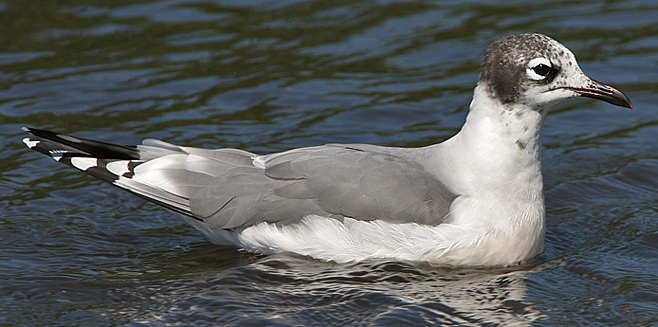|
Larus pipixcan (Franklin's
gull)
Franklinse meeu [Afrikaans]; Franklin-meeuw [Dutch];
Mouette de Franklin [French]; Franklins möwe [German]; Gaivota de
Franklin [Portuguese]
Life
> Eukaryotes >
Opisthokonta
> Metazoa (animals) >
Bilateria >
Deuterostomia > Chordata >
Craniata > Vertebrata (vertebrates) > Gnathostomata (jawed
vertebrates) > Teleostomi (teleost fish) > Osteichthyes (bony fish) > Class:
Sarcopterygii (lobe-finned
fish) > Stegocephalia (terrestrial
vertebrates) > Tetrapoda
(four-legged vertebrates) > Reptiliomorpha > Amniota >
Reptilia (reptiles) >
Romeriida > Diapsida > Archosauromorpha > Archosauria >
Dinosauria
(dinosaurs) > Saurischia > Theropoda (bipedal predatory dinosaurs) >
Coelurosauria > Maniraptora > Aves
(birds) > Order: Charadriiformes
> Family: Laridae > Genus: Larus
 |
|
Franklin's gull in non-breeding plumage, Strandfontein Sewerage Works,
South Africa. [photo Trevor Hardaker ©] |
Distribution and habitat
Breeds in the interior of North Africa, travelling south in
the non-breeding season to the Pacific coast of south America; it is a
vagrant to Australia, central Pacific islands, Europe and Africa. Within
southern Africa it has been recorded several times on the coast of the
south-Western Cape, central Namibia, Eastern Cape and KwaZulu-Natal, with a
single record inland at Rolfe's Pan, Gauteng. It generally prefers open
coastline, sheltered coastal lagoons, estuaries and sewage ponds.
References
-
Hockey PAR, Dean WRJ and Ryan PG 2005. Roberts
- Birds of southern Africa, VIIth ed. The Trustees of the John Voelcker
Bird Book Fund, Cape Town.
|
